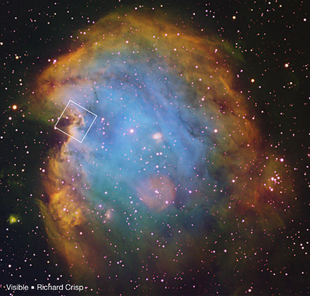NGC 2174
| Emissionsnebel | |
|---|---|
| NGC 2174 | |
 | |
| Aufnahme mit Linienfilter für SII, Hα, OIII | |
| AladinLite | |
| Sternbild | Orion |
| Position Äquinoktium: J2000.0, Epoche: J2000.0 | |
| Rektaszension | 06h 09m 23,6s[1] |
| Deklination | +20° 39′ 34″[1] |
| Erscheinungsbild | |
| Scheinbare Helligkeit (visuell) | 6,9 mag |
| Winkelausdehnung | 40' × 30'[2] |
| Ionisierende Quelle | |
| Physikalische Daten | |
| Entfernung | 6400 Lj |
| Geschichte | |
| Entdeckung | Édouard Stephan |
| Datum der Entdeckung | 6. Februar 1877 |
| Katalogbezeichnungen | |
| NGC 2174 • Sh2-252 • LBN 854 • CED 67A | |
NGC 2174 ist ein H-II-Emissionsnebel im Sternbild Orion, der etwa 6400 Lichtjahre von der Erde entfernt ist.
Die Größe des Nebels beträgt circa 40 Bogenminuten. Der Durchmesser beträgt 75 Lichtjahre. Er wird auch Affenkopfnebel genannt, weil er dem Kopf eines Makaken ähnlich sieht.
Das Objekt wurde am 6. Februar 1877 von Édouard Stephan entdeckt.[3]
HST-Aufnahme mit einem Ausschnitt des Nebels
Infrarotaufnahme der gleichen Stelle, Hubble-Weltraumteleskop
Weblinks
- Gasnebel NGC 2174
- Fiery young stars wreak havoc in stellar nursery
- GoBlack - NGC 2174
- SIMBAD Query - NGC 2174
- NGC 2174: Emission Nebula in Orion – Astronomy Picture of the Day vom 8. Dezember 2006 (englisch).
- Spektrum.de: Amateuraufnahmen [1][2][3][4][5]
Einzelnachweise
Auf dieser Seite verwendete Medien
The NASA/ESA Hubble Space Telescope has imaged a violent stellar nursery called NGC 2174, in which stars are born in a first-come-first-served feeding frenzy for survival.
The problem is that star formation is a very inefficient process; most of the ingredients to make stars are wasted as the cloud of gas and dust, or nebula, gradually disperses. In NGC 2174, the rate at which the nebula disperses is further speeded up by the presence of hot young stars, which create high velocity winds that blow the gas outwards.
These fiery youngsters also bombard the surrounding gas with intense radiation, making it glow brightly, creating the brilliant scene captured here. The nebula is mostly composed of hydrogen gas, which is ionised by the ultraviolet radiation emitted by the hot stars, leading to the nebula’s alternative title as an HII region. This picture shows only part of the nebula, where dark dust clouds are strikingly silhouetted against the glowing gas.
NGC 2174 lies about 6400 light-years away in the constellation of Orion (The Hunter). It is not part of the much more familiar Orion Nebula, which lies much closer to us. Despite its prime position in a very familiar constellation this nebula is faint and had to wait until 1877 for its discovery by the French astronomer Jean Marie Edouard Stephan using an 80 cm reflecting telescope at the Observatoire de Marseille.
This picture was created from images from the Wide Field Planetary Camera 2 on Hubble. Images through four different filters were combined to make the view shown here. Images through a filter isolating the glow from ionised oxygen (F502N) were coloured blue and images through a filter showing glowing hydrogen (F656N) are green. Glowing ionised sulphur (F673N) and the view through a near-infrared filter (F814W) are both coloured red. The total exposure times per filter were 2600 s, 2600 s, 2600 s and 1000 s respectively and the field of view is about 1.8 arcminutes across.Autor/Urheber:
- Heic1406d.tif: Credit: NASA and ESA / Acknowledgment: NASA, ESA, and the Hubble Heritage Team (STScI/AURA), and R. Crisp
- derivative work: Fabian RRRR
Location of the Hubble IR Detail in NGC 2174 Location of the Hubble IR Detail in NGC 2174 Click to Enlarge This image shows the region of NGC 2174, taken in infrared and released for Hubble's 24th birthday, in its wider context. On the left is a ground based image taken by an amateur astrophotographer of the star-forming nebula in visible light, with an outline showing the area of the detailed Hubble image. On the right is a small detail of a star-forming column in the nebula, made by Hubble's WFC3 infrared camera. Credit: NASA and ESA Acknowledgment: NASA, ESA, and the Hubble Heritage Team (STScI/AURA), and R. Crisp
Autor/Urheber: Credit: NASA, ESA, and the Hubble Heritage Team (STScI/AURA), Lizenz: CC BY 3.0
New Hubble image of NGC 2174
To celebrate its 24th year in orbit, the NASA/ESA Hubble Space Telescope has released this beautiful new image of part of NGC 2174, also known as the Monkey Head Nebula.
NGC 2174 lies about 6400 light-years away in the constellation of Orion (The Hunter). Hubble previously viewed this part of the sky back in 2011 — the colourful region is filled with young stars embedded within bright wisps of cosmic gas and dust.
This portion of the Monkey Head Nebula was imaged in the infrared using Hubble's Wide Field Camera 3.
Credit:
NASA, ESA, and the Hubble Heritage Team (STScI/AURA)
About the Object
Name: NGC 2174
Type: • Milky Way : Nebula : Appearance : Emission : H II Region
• X - Nebulae Images/Videos
Distance: 6500 light years
Colours & filters Band Wavelength Telescope Infrared Y 1.05 μm Hubble Space Telescope WFC3 Infrared J 1.25 μm Hubble Space Telescope WFC3 Infrared H 1.6 μm Hubble Space Telescope WFC3.




